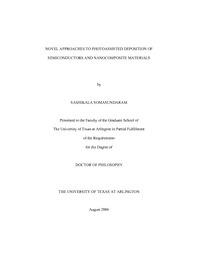
ATTENTION: The works hosted here are being migrated to a new repository that will consolidate resources, improve discoverability, and better show UTA's research impact on the global community. We will update authors as the migration progresses. Please see MavMatrix for more information.
Show simple item record
| dc.contributor.author | Somasundaram, Sashikala | en_US |
| dc.date.accessioned | 2007-08-23T01:56:41Z | |
| dc.date.available | 2007-08-23T01:56:41Z | |
| dc.date.issued | 2007-08-23T01:56:41Z | |
| dc.date.submitted | August 2006 | en_US |
| dc.identifier.other | DISS-1439 | en_US |
| dc.identifier.uri | http://hdl.handle.net/10106/409 | |
| dc.description.abstract | This dissertation research begins with the use of TiO2-based photocatalysis for the reduction of metal ions with very negative reduction potentials. The indirect photocatalytic reduction of four metal ions: Cd2+, Zn2+, Mn2+, and Tl+ using formate radical anions generated in UV-irradiated aqueous TiO2 suspensions, is described. Using Tl+ as a model metal ion, a simple kinetics scheme was developed for the indirect reduction route, and the predictions from this model were shown to be in excellent agreement with experimental data. Titania-based photocatalysis was then used for the preparation of MSe/TiO2 "coupled" semiconductors. Heterogeneous photocatalysis using photoexcited TiO2 substrates was shown to be a versatile method for preparing Se- or metal selenide (MSe)- modified TiO2 surfaces. The mechanistic aspects underlying this novel preparative route were addressed using chronopotentiometry and linear sweep photovoltammetry. Ex situ characterization of the prepared composite semiconductor samples was also carried out.
The cathodic electrosynthesis of WO3-TiO2 nanocomposites or layered films is then described. This part of the dissertation describes the preparation of WO3-TiO2 nanocomposite films by occlusion electrosynthesis and pulsed electrodeposition. These methods are shown to afford semiconductor composites with better photoresponse than its individual members.
The final part of the dissertation describes visible light-driven hydrogen production from water using electrodeposited p-type Cu2O films. This study resolves the controversy which existed on the ability of p-Cu2O to sustain the photoassisted splitting of water into H2 and O2. While p-Cu2O is shown to be incapable of splitting water, the present study shows that H2 can be generated by substituting water with an organic compound (e.g., hydroquinone) as a sacrificial electron donor. The implications of this study for constructing practical systems for solar-assisted production of H2 from water are finally discussed. | en_US |
| dc.description.sponsorship | Rajeshwar, Krishnan | en_US |
| dc.language.iso | EN | en_US |
| dc.publisher | Chemistry & Biochemistry | en_US |
| dc.title | Novel Approaches To Photoassisted Deposition Of Semiconductors And Nanocomposite Materials | en_US |
| dc.type | Ph.D. | en_US |
| dc.contributor.committeeChair | Rajeshwar, Krishnan | en_US |
| dc.degree.department | Chemistry & Biochemistry | en_US |
| dc.degree.discipline | Chemistry & Biochemistry | en_US |
| dc.degree.grantor | University of Texas at Arlington | en_US |
| dc.degree.level | doctoral | en_US |
| dc.degree.name | Ph.D. | en_US |
| dc.identifier.externalLink | https://www.uta.edu/ra/real/editprofile.php?onlyview=1&pid=101 | |
| dc.identifier.externalLinkDescription | Link to Research Profiles | |
Files in this item
- Name:
- umi-uta-1439.pdf
- Size:
- 2.065Mb
- Format:
- PDF
This item appears in the following Collection(s)
Show simple item record


